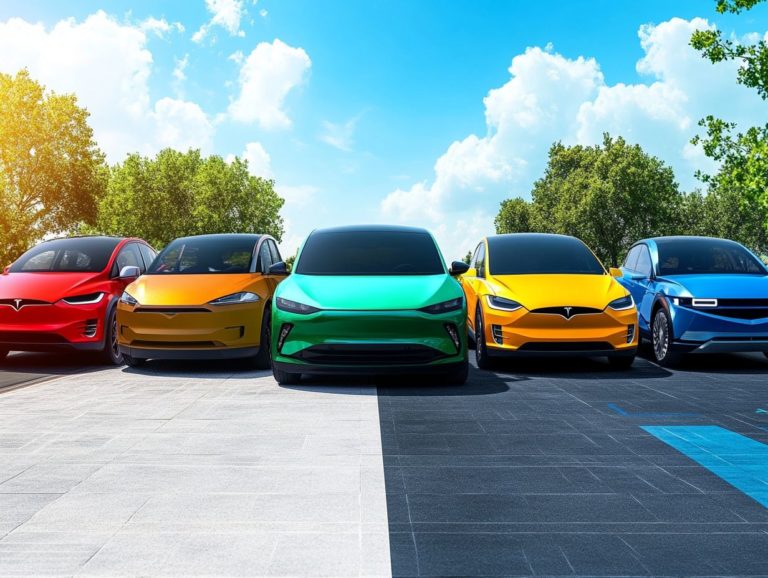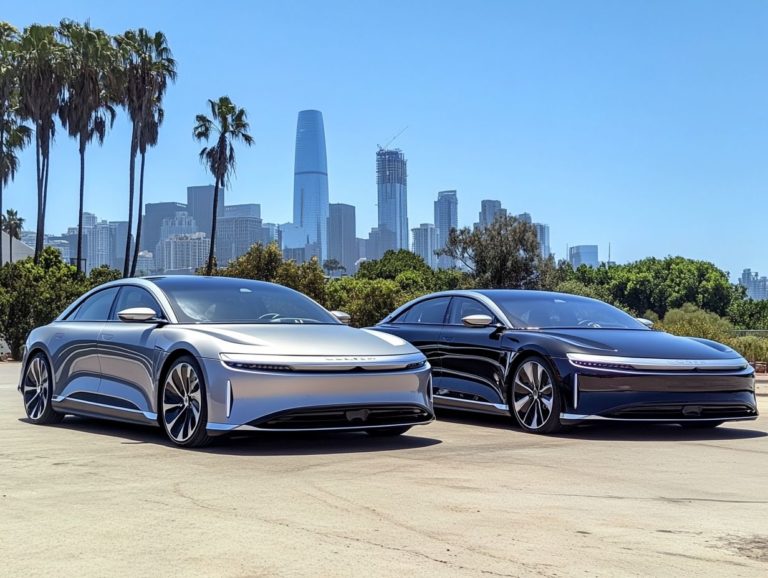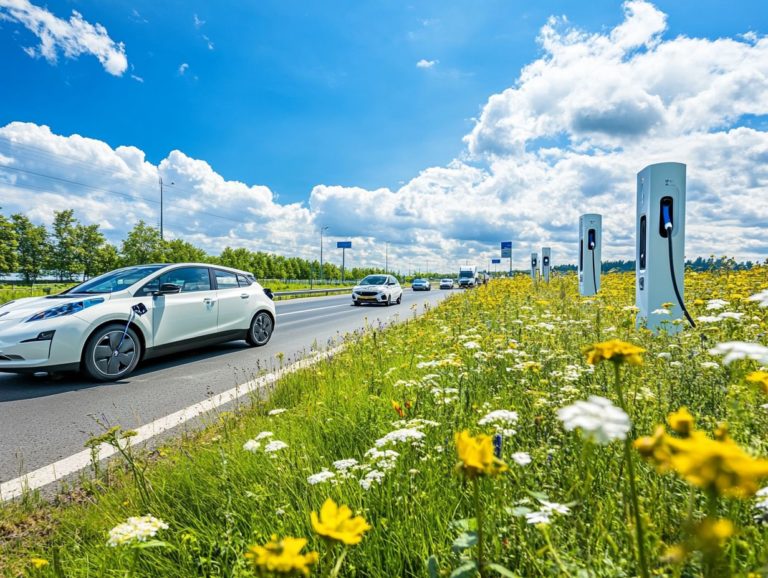How to Choose Between EV Models: A Guide
Electric vehicles (EVs) are revolutionizing transportation by providing a cleaner and more sustainable alternative to conventional cars.
With a range of options at your disposal including Battery Electric Vehicles (BEVs), Plug-in Hybrid Electric Vehicles (PHEVs), and Fuel Cell Electric Vehicles (FCEVs) the selection process can seem daunting.
This article guides you through the different types of EVs, highlights key factors to consider when making your decision, and equips you with the tools to effectively evaluate and compare models. By doing so, you’ll find the perfect match for your lifestyle.
Contents
- Key Takeaways:
- What are EVs and Why Choose One?
- Types of EVs
- Factors to Consider When Choosing an EV
- How to Evaluate and Compare Different EV Models
- Frequently Asked Questions
- What factors should I consider when choosing between EV models?
- How do I determine the range of an EV model?
- What are my options for charging an EV?
- Is the battery life of an EV something to consider?
- Are there any incentives or rebates for purchasing an EV?
- Which features should I prioritize when choosing between EV models?
Key Takeaways:
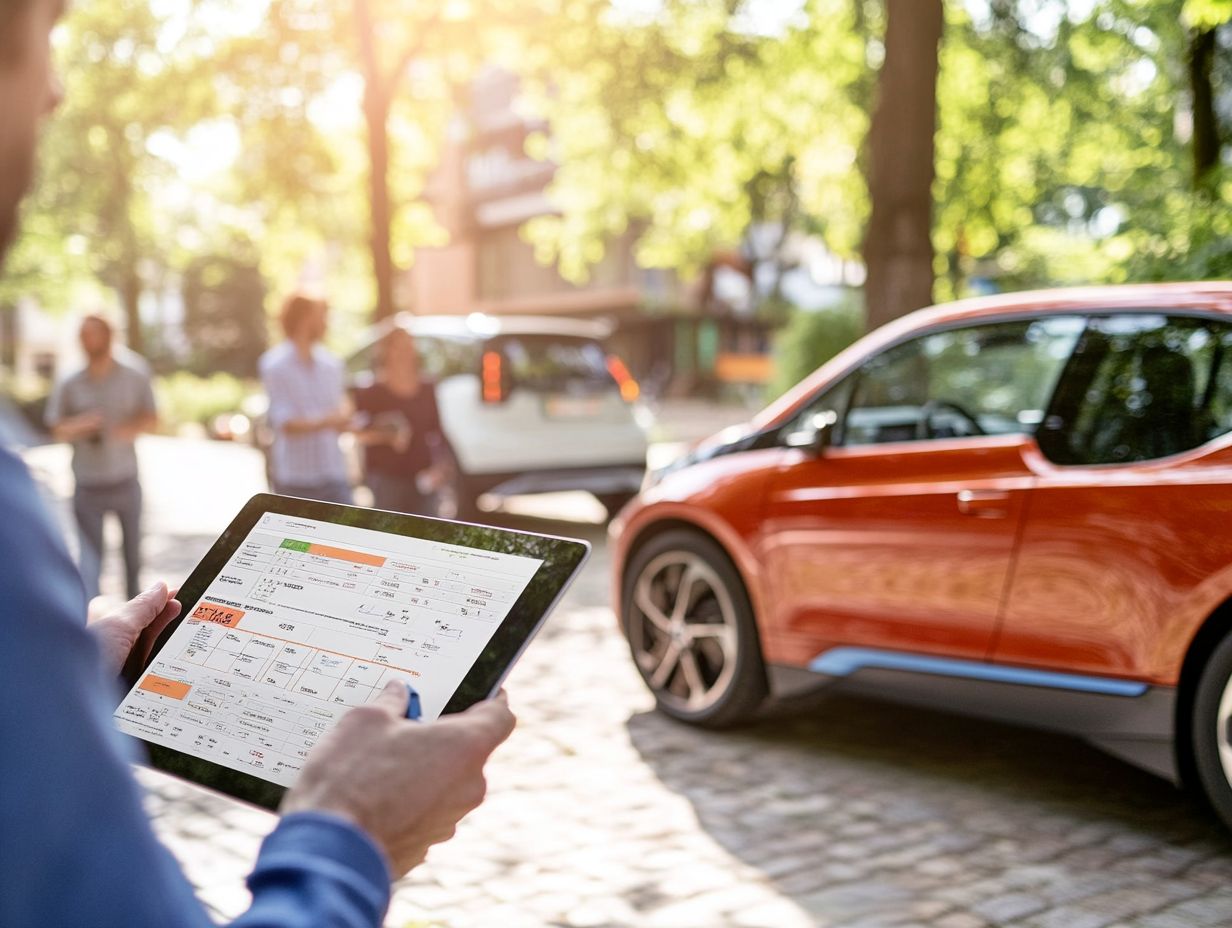
- Consider your needs and preferences to determine which type of EV (BEV, PHEV, or FCEV) is the best fit for you.
- When evaluating EV models, prioritize factors such as range, charging options, cost, performance, and environmental impact.
- Research and test drive multiple EV models, and use online tools to compare and make an informed decision.
What are EVs and Why Choose One?
Electric vehicles (EVs) signify a transformative shift in the transportation sector. They provide sustainable alternatives to traditional gasoline-powered cars.
By choosing an EV, you significantly reduce pollution from the exhaust and support the use of renewable energy sources.
Whether you opt for a battery electric vehicle (BEV) like the Tesla Model 3 or Chevrolet Bolt or a plug-in hybrid, you re not just stepping into the future of transportation you re saving money!
Consumers are increasingly drawn to fast charging solutions, including DC fast charging at convenient stations. This helps alleviate worries about running out of battery power while driving.
Types of EVs
Understanding the various types of electric vehicles (EVs) is essential as you consider switching to more sustainable transportation options. The market primarily features three classifications: battery electric vehicles (BEVs), plug-in hybrid electric vehicles (PHEVs), and fuel cell electric vehicles (FCEVs).
Each type comes with unique benefits and features, suited to different driving needs. For example, BEVs like the Tesla Model 3 and Chevrolet Bolt operate solely on electricity. In contrast, PHEVs blend traditional fuel sources with electric capabilities, offering flexibility on the road.
FCEVs are less common but utilize hydrogen as a power source, showcasing another innovative option in the EV landscape.
Battery Electric Vehicles (BEVs)
Battery Electric Vehicles (BEVs) epitomize electric innovation. They rely entirely on electric power and harness cutting-edge charging technology to replenish their lithium batteries. This cuts down on pollution from the exhaust and reduces reliance on fossil fuels.
Take the Tesla Model 3, for instance it showcases what BEVs can achieve by tapping into renewable energy sources while addressing concerns about running out of battery power with its expansive charging infrastructure.
BEVs predominantly draw energy from renewable resources like solar and wind, making a tangible impact on your carbon footprint. With typical ranges of 200 to 300 miles on a single charge, modern BEVs are designed to fit seamlessly into your daily life.
Models like the Nissan Leaf and Chevrolet Bolt are gaining traction among eco-conscious drivers.
Thanks to rapid advancements in charging technology, including fast chargers that can rejuvenate batteries in under an hour, worries about charging times are becoming a thing of the past. The rise of BEVs not only signifies a shift toward sustainable energy solutions but also paves the way for a cleaner, more efficient transportation landscape.
Plug-in Hybrid Electric Vehicles (PHEVs)
PHEVs offer an enticing option for flexibility. They combine a traditional engine with an electric motor.
This setup reduces transportation costs and lowers maintenance needs. Imagine charging your PHEV conveniently at home or on the go at public stations.
This leads to savings at the pump while minimizing emissions compared to conventional vehicles.
PHEVs can switch between electric power for short trips and gasoline for longer journeys. This versatility is attractive as fuel prices change.
Maintaining a PHEV is often cheaper because electric motors need less upkeep. Popular models like the Toyota Prius Prime and Ford Escape PHEV blend stylish designs with practicality.
Fuel Cell Electric Vehicles (FCEVs)
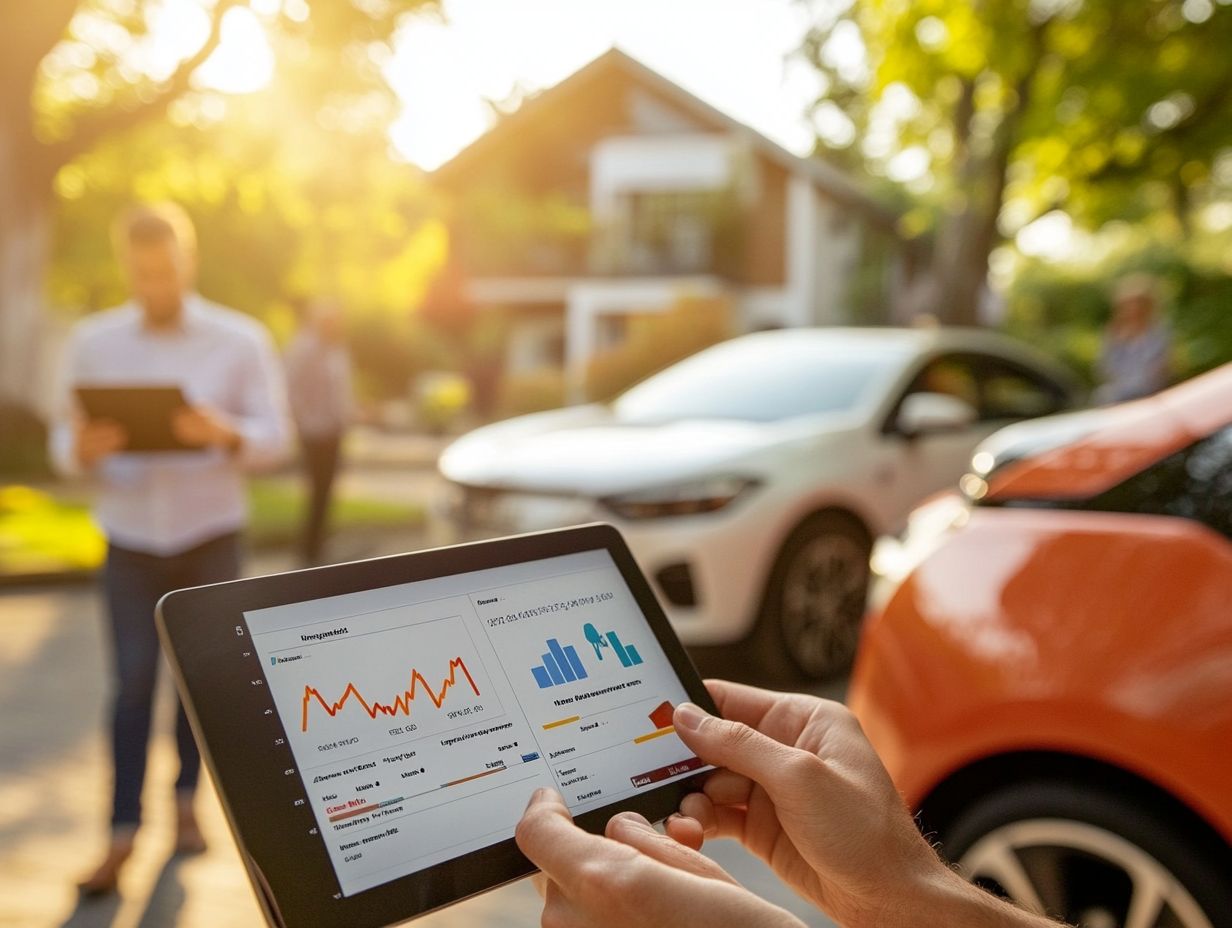
FCEVs represent an exciting frontier in electric vehicle technology. They use hydrogen fuel cells to generate electricity with zero emissions.
Their rapid refueling capabilities make them increasingly popular. The growing hydrogen infrastructure supports this trend.
A chemical reaction between hydrogen and oxygen generates electricity, producing only water as a byproduct. This makes FCEVs cleaner than Battery Electric Vehicles (BEVs) and PHEVs.
FCEVs can outperform BEVs in certain conditions. However, the lack of hydrogen refueling stations is a significant barrier.
Both FCEVs and BEVs face infrastructure challenges that affect consumer choices. Thoughtful planning is needed for sustainable transportation.
Factors to Consider When Choosing an EV
When selecting an electric vehicle (EV), consider key factors to match your preferences. It’s important to think about range, charging options, cost, performance, and how to determine your EV needs to ensure you make the best choice for your lifestyle and environmental impact.
These elements help determine the suitability of an EV model. Electric vehicle incentives can significantly lower your upfront expenses.
Range
Range is crucial when purchasing an EV. It impacts usability and can lead to range anxiety if not addressed.
Today’s EVs use advanced charging technology and high-capacity batteries for impressive ranges. These easily meet daily driving needs.
Range varies widely among models, influenced by weight, aerodynamics, and driving modes. Efficient models can exceed 300 miles on a single charge.
Advancements in battery technology, like solid-state and higher energy density batteries, push these limits further. The growing network of fast-charging stations eases range anxiety.
Charging Options
Charging options for electric vehicles (EVs) are crucial for your convenience and accessibility. With a variety of technologies available, from home charging stations to public infrastructure, there’s something to meet your specific needs.
Setting up a home charging station lets you recharge overnight, making your routine hassle-free. Public charging stations are invaluable for those moments when home charging isn’t an option, especially during longer journeys.
The emergence of DC fast charging stations has changed the game, allowing you to replenish your battery in a fraction of the time conventional chargers offer. This rapid charging capability transforms road trips, giving you the flexibility and confidence to explore, knowing that a growing network of fast chargers is conveniently located in urban centers.
Cost
The cost of electric vehicles (EVs) plays a pivotal role in your decision-making journey. It encompasses everything from the initial purchase price to operational costs and potential savings over time from reduced fuel and maintenance expenses.
Various electric vehicle incentives and government programs can alleviate the upfront financial burden. This ultimately positions EVs as a financially savvy choice for many consumers.
As you evaluate the overall expense of transitioning to an electric vehicle, consider not only these incentives and rebates but also the long-term savings that come with lower fuel costs.
Unlike traditional gasoline vehicles, which expose you to fluctuating prices at the pump, electric vehicles offer the convenience of home charging at a fraction of the cost. The maintenance demands for EVs are generally lower, thanks to fewer moving parts and less frequent service needs.
For those weighing the pros and cons, exploring these financial aspects can illuminate a path toward a more sustainable and economical driving experience.
Performance
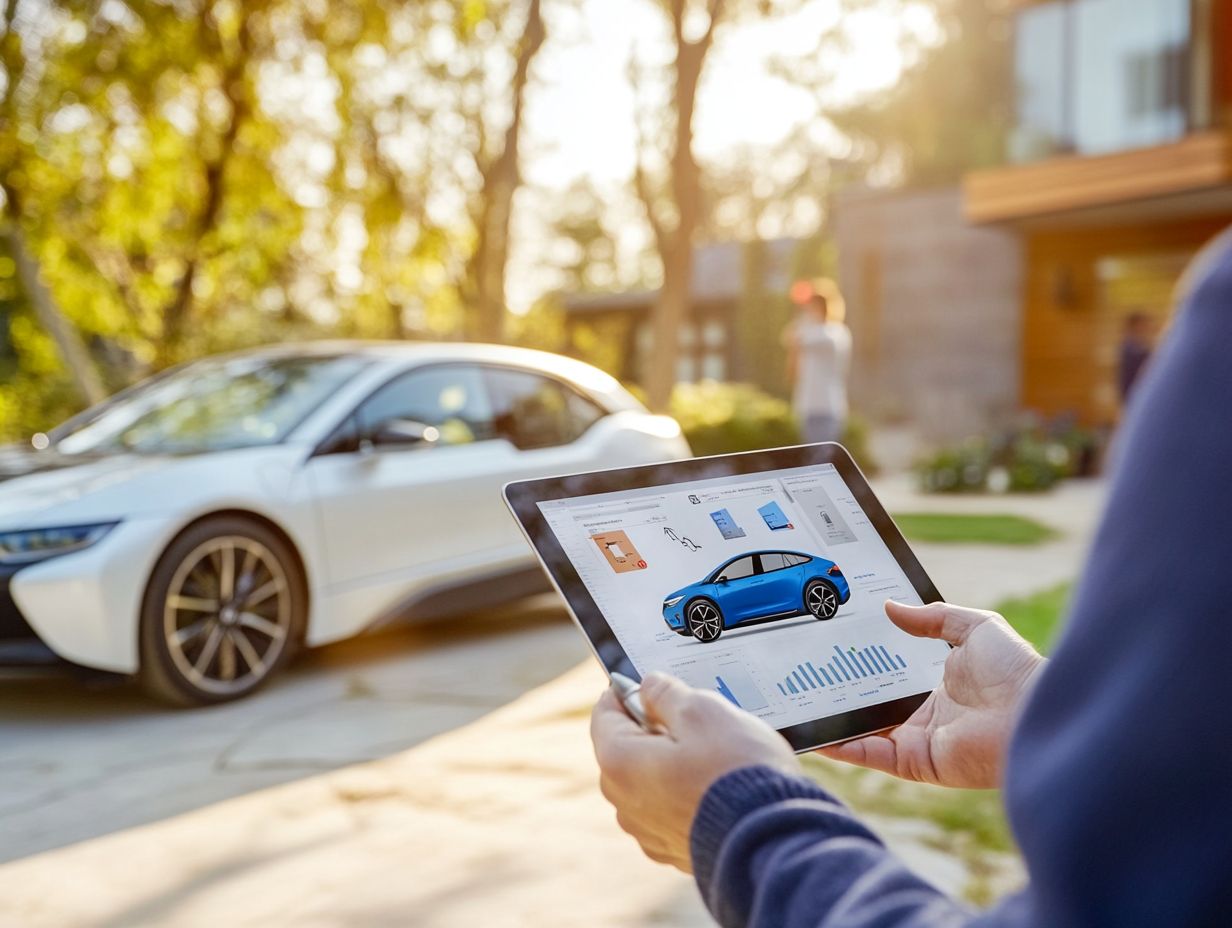
Performance is critical in your vehicle choice, and electric vehicles (EVs) present unique advantages that elevate the driving experience. With instant torque and enhanced driving dynamics often improved by features like regenerative braking EVs maximize energy efficiency.
You’ll find that the performance metrics vary significantly among different models. It’s essential to align your driving preferences with the options available.
These distinctive characteristics create an exhilarating driving experience. EVs typically accelerate faster than traditional internal combustion engine vehicles due to their instant power delivery.
This acceleration heightens the thrill of driving and enhances handling, allowing for more agile maneuvers. Regenerative braking a feature that recycles energy to extend battery life extends your range by recapturing energy during deceleration.
Understanding these unique performance traits can greatly influence your choices as a potential buyer. This ensures your selection perfectly aligns with your lifestyle and driving habits.
Environmental Impact
The environmental impact of electric vehicles (EVs) is significant, primarily because they eliminate tailpipe emissions and help reduce overall carbon footprints. Charging with renewable energy sources makes a difference for the environment and supports global efforts to combat climate change.
Transitioning from gasoline vehicles to electric alternatives marks a transformative leap toward sustainable transportation. These vehicles can dramatically cut air pollution in urban areas, improving public health.
When charged with solar or wind energy, their carbon footprint decreases even more. However, it’s essential to think about the potential environmental concerns associated with battery production and disposal.
The mining and processing of materials like lithium and cobalt can have negative ecological impacts. Prioritizing advancements in recycling technologies and sustainable mining practices is crucial, ensuring that your shift to electric driving remains beneficial for our planet.
How to Evaluate and Compare Different EV Models
When considering the purchase of an electric vehicle (EV), evaluating and comparing different models is a crucial step in your decision-making process. For a thorough approach, check out this guide on how to choose the right EV for your lifestyle, which involves careful research, taking the time to test drive options, and using various online tools.
These strategies give you valuable insights into the performance, features, and overall suitability of various EVs, enabling you to learn how to compare EV models effectively and choose a model that perfectly aligns with your lifestyle and needs.
Researching and Test Driving
Researching and test-driving electric vehicles (EVs) are essential steps in your decision-making journey. They allow you to gather vital insights about different models, their performance features, and how to find the right EV for your commute based on the experiences of other users.
A hands-on test drive immerses you in the unique driving dynamics and comfort that EVs offer. This makes it easier to pinpoint the right vehicle for your needs.
Your research should extend beyond mere specifications; delve into the reviews and testimonials from current owners. This exploration will help you grasp which features truly elevate the driving experience and which may not meet your expectations.
By comparing various models, you can uncover critical elements such as battery life, charging infrastructure, and safety ratings. For a deeper insight, refer to this guide on how to understand EV model comparisons. Test-driving different EVs will bolster your confidence as you evaluate handling, ride comfort, and the integration of technology firsthand.
Ultimately, this mix of insights and hands-on experience empowers you to make a more informed and satisfying purchase decision!
Using Online Tools and Resources
Utilizing online tools and resources is a smart strategy for you as a prospective electric vehicle (EV) buyer. These resources provide access to comprehensive vehicle comparisons, cost analyses, and user testimonials. They can significantly aid your decision-making process.
With side-by-side comparisons of various EV models and their respective features, you are enabled to make well-informed choices about how to identify your ideal EV.
In today’s digital age, countless platforms are available to streamline your research. They help you navigate through a myriad of options. Websites dedicated to EV evaluations offer detailed insights into performance data, battery life, and charging capabilities, while also breaking down the overall expenses of owning the vehicle, including incentives and rebates. For those considering a purchase, learning how to choose between hybrid and electric can be invaluable.
Forums and review sites allow you to tap into personal experiences and stories from other users. This provides real-world perspectives that can further guide your choice. By leveraging these user-friendly platforms, you can easily sift through the noise, leading to more confident purchasing decisions.
Frequently Asked Questions
Here are some common questions potential EV buyers have:

What factors should I consider when choosing between EV models?
Some important factors to consider include range, charging options, battery life, price, and available features.
How do I determine the range of an EV model?
The range refers to the distance an EV can travel on a single charge. This can vary depending on the make and model, but you can typically find this information listed on the manufacturer’s website or in the vehicle’s manual.
What are my options for charging an EV?
Most EV models offer both at-home charging with a regular outlet and fast charging at public charging stations. Some models may also have the option for a home charging station to be installed for faster and more convenient charging.
Is the battery life of an EV something to consider?
Yes, the battery life is an important factor. A longer battery life means less frequent charging and potentially longer use of the vehicle before needing to replace the battery.
Are there any incentives or rebates for purchasing an EV?
Yes, many countries and states offer incentives and rebates for purchasing an EV. These can include tax credits, rebates on the purchase price, and discounts on charging equipment. Be sure to research and take advantage of any available incentives in your area.
Which features should I prioritize when choosing between EV models?
Your choice will depend on your personal preferences and needs. Start by identifying the key features that matter most to you.
Consider safety features that help protect you, user-friendly navigation systems, and seamless smartphone integration. To make the best decision, refer to a guide on how to choose the best EV for city driving and make a list of your must-haves while comparing these features across different EV models!



